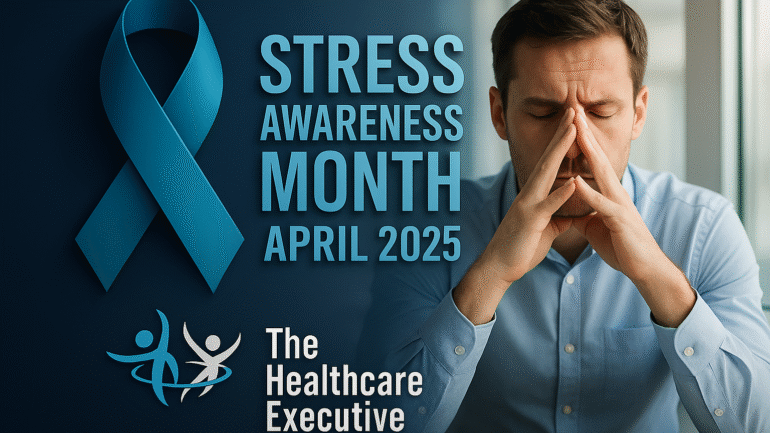Stress Awareness and Prevention Month – April 2025

- Posted by Greg Wahlstrom, MBA, HCM
- Posted in Health Observance Calendar
Resilient Leadership in a High-Stakes Environment
Published: April 1, 2025
April marks Stress Awareness and Prevention Month, a national observance that takes on renewed urgency within the healthcare sector in 2025. Hospital leaders today operate under unprecedented pressure—from persistent staffing shortages and rising acuity to regulatory shifts and cost containment demands. The cumulative impact on executive and frontline teams has become a critical risk factor in itself. Stress, when unmanaged, compromises clinical judgment, erodes team trust, and contributes directly to burnout and turnover. Addressing it is no longer a wellness perk—it’s a leadership imperative. According to the American Psychological Association, 77% of adults report physical symptoms caused by stress, and healthcare professionals are significantly overrepresented in this statistic. Left unchecked, organizational stress undermines patient safety, strategic execution, and long-term viability. The time has come for executives to reframe stress prevention not as an HR initiative, but as core infrastructure. Every hospital board and CEO must ask: What mechanisms have we implemented to detect, address, and reduce chronic workplace stress across every level of the organization?
Leading systems are answering this call with evidence-based, executive-supported strategies. For example, UCHealth has implemented structured stress management tools embedded directly into staff workflows, including guided breathing breaks, psychological safety check-ins, and real-time wellness analytics. At Mass General Hospital, department chairs work with mental health professionals to debrief care teams after high-impact trauma cases—helping to prevent stress accumulation before it evolves into burnout. Both organizations treat emotional resilience as a system-level competency, not an individual burden. These practices are not merely wellness trends—they are strategic interventions aligned with workforce retention, patient satisfaction, and clinical quality. Executives at these institutions also integrate stress-related indicators into regular dashboards, treating them with the same gravity as infection control or readmission metrics. The lesson is clear: leaders who normalize recovery create cultures that endure. Especially in 2025, when healthcare faces extreme volatility, executives must model vulnerability, resource access, and calm decisiveness in the face of disruption.
Yet stress mitigation is not just an operational challenge—it is a cultural and communicative one. Executives must build environments where expressing overwhelm is not taboo, and where clinical staff feel heard and supported. According to Cedars-Sinai Health System, regular pulse surveys, town hall forums, and anonymous helplines are essential to capturing early signs of distress. Their system-wide de-escalation training also empowers staff to protect themselves in volatile patient situations—proactively reducing one of the fastest-growing stress triggers in modern care. Meanwhile, executives at OSF HealthCare are using digital wellness coaching platforms to match employees with personalized self-care programs across nutrition, sleep, and emotional regulation. These aren’t fringe benefits—they’re frontline investments. The common thread across these examples is intentionality from the top. Without leadership advocacy, most stress programs falter from poor uptake or lack of cultural buy-in. Therefore, hospital CEOs must ensure that all supervisors are trained not only in metrics, but in emotional intelligence. This shift, when authentically led, builds trust and loyalty that no incentive bonus ever could.
Stress prevention also requires external collaboration and community integration. Isolation is a catalyst for professional distress, particularly in rural and under-resourced systems. Leaders at Ochsner Health have launched peer-to-peer support groups that connect physicians across facilities, creating space to discuss the human cost of leadership in a high-stakes field. Likewise, Henry Ford Health has partnered with city wellness coalitions to offer hospital employees access to outdoor recovery zones and mindfulness therapy sessions. These partnerships move wellness from internal policy to public collaboration. Executives who embrace this approach strengthen not only their workforce—but their system’s social capital and brand trust. When communities see that health systems care for their own caregivers, institutional loyalty grows. Forward-thinking CEOs now understand that stress mitigation is a reputational asset. It directly influences recruitment, public perception, and stakeholder engagement. Especially in an era of transparency, workforce well-being is no longer private. It is a leadership signal to the entire healthcare ecosystem.
As we recognize Stress Awareness and Prevention Month in April 2025, let this serve as a call to action for every hospital executive, board member, and C-suite leader. The days of dismissing stress as “part of the job” are over. Today, it is a measurable risk factor—and a solvable one. Leadership must begin with self-audits and courageous conversations. What are we modeling? What resources have we allocated? What results are we tracking? The answers to these questions shape institutional culture more than any mission statement. Let April be the month executives recommit to sustainable, emotionally intelligent leadership. Whether through better data, improved access to care, or authentic cultural shifts, your people need to see—and feel—that you are invested in their wholeness. Because in 2025, trust is built through well-being, and the most successful systems will be led not just by visionary strategists, but by present, grounded human beings who lead with care. Your staff’s resilience starts with your decisions. And there’s no better time to begin than now.
Discover More:
Read our in-depth leadership feature on how to rebuild trust, transparency, and workforce connection across healthcare systems.
Internal Links:
- Rebuilding Trust in U.S. Healthcare: A Leadership Blueprint
- Trust as a Strategic Asset: Reputation, Outcomes, and the Patient Voice
- Navigating Regulatory Changes in Healthcare: 2024 A Guide for Executives
External Links:
- Stress Management Society – Stress Awareness Month 2025
- APA – Stress in America 2023 Report
- UCHealth – Practical Stress Tools
- Mass General – Stress Resource Guide
- Cedars-Sinai – Burnout in Healthcare
- OSF HealthCare – Wellness Program
- Ochsner Health – Stress Resources
- Henry Ford Health – 2023 Campaign



